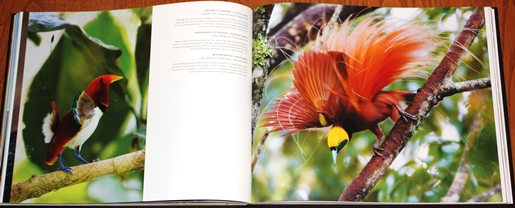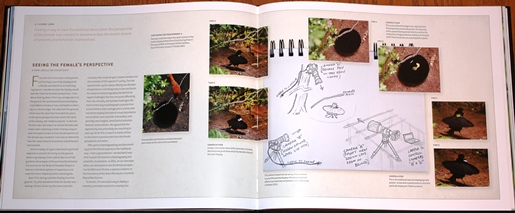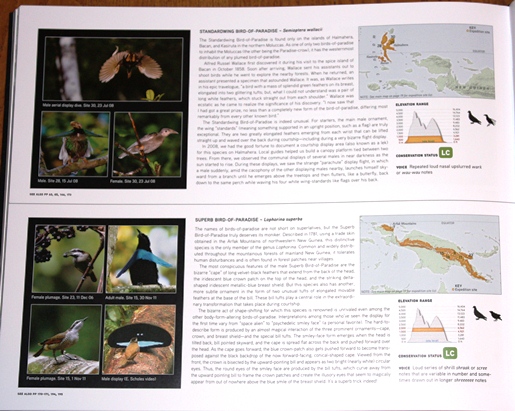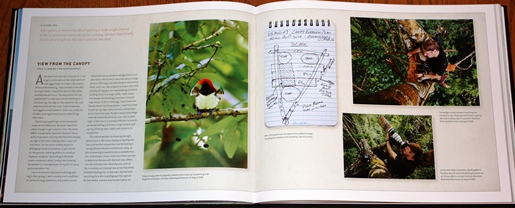Reviewed by Grant McCreary on February 19th, 2014.
Is there any other group of birds as amazing, as unearthly, as the birds-of-paradise? In fact, for a while after the first specimen of this family made its way to Europe, people believed that these birds were literally not of this earth but from paradise. Where else can you find crazy adornments like that of Resplendent Quetzals, sparkling iridescence rivaling hummingbirds, courtship rituals that put grouse to shame, and other things so bizarre as to have no comparison – all in a single family? It’s no wonder that the birds-of-paradise have inspired people for centuries.
Two of those people are Tim Laman and Edwin Scholes. Laman, a scientist/photographer, and Scholes, an ornithologist, met in 2004 and began a collaboration that became the Birds-of-Paradise Project. This ambitious undertaking started as an attempt to photograph all 39 species of birds-of-paradise, but evolved into a larger effort to further our understanding of these birds and promote the conservation and appreciation of the New Guinea region in which they live. After eight years, this project has yielded numerous magazine articles, a National Geographic TV program, a traveling exhibit, and this book – Birds of Paradise: Revealing the World’s Most Extraordinary Birds.
The first thing you’ll notice upon opening this coffee-table-style book is the photographs. The birds-of-paradise are very photogenic and you will see them here in all their glory, with beautiful, large (often full-page or nearly so) photos. There are too many great ones to pick out a favorite, but pretty much any shot of a displaying bird is sure to illicit a “Wow!”
But these photos aren’t just amazing looking, they also show these birds as you’ve never seen them before. I can say this with certainty because this team photographed behaviors never before captured on film, and some that have never been witnessed at all (at least not by non-natives). But my favorite is when they looked at one well-known courtship display from a new perspective and found something really cool. You may have seen video of a bird-of-paradise doing a very funny looking “ballerina dance”. This would be one of several species of parotia. In this display, the male will take his place on a stage that he has cleared of leaves, raise a cone of feathers that resembles a tutu, waive about specialized head plumes, and prance around. It’s an amazing sight, and more than a little comical! But this display has always been filmed from the ground level and, as the authors note, the female parotias view the performances from a perch above the male. What would it look like from this point of view? To find out, they set up an elaborate system that included three cameras, a laptop, and more than 60 meters of cable. At long last:
After weeks of effort, we came down to the final hours before we had to pack up our camp for good. Gloriously, the results were far better than we’d hoped. Not only did we see a displaying male as a female would see him, but we also made a surprising new discovery. Although we knew the ballerina-displaying male would look different from above, we were amazed at just how different it was. The name “ballerina dance” no longer seemed accurate. The male was enacting more of a “wobbling ovoid” display!
Further, they discovered how all the various iridescent feather patches of the male were utilized. Written descriptions do not do this justice, you really need to see it for yourself.
The text provides an interpretation of the displays and behaviors illustrated in the photos, and much more. The authors give an overview of the family, including taxonomy and basic natural history information, explore their habitat, and describe how the birds-of-paradise came to look and behave so outrageously. The chapters are further augmented by “closer looks” at such things as the history of the birds’ discovery, the life of the naturalist in the field, the extraordinary ornamental feathers, the difficulty in photographing some species, and conservation in New Guinea.
At the end of the book is a “Species Atlas”, where each of the 39 birds-of-paradise is presented in a half-page account that includes:
- Photos – one to four photos
- A short essay – description of the bird and its display, along with other interesting facts
- Range map
- Elevation range graphic
- Illustration showing relative size – silhouette compared against a pigeon
- Voice description
- Conservation status
Birds of Paradise was written for anyone interested in nature. The writing is easily understandable and if any technical terms are used they are clearly defined. So please don’t expect a level of detail comparable to an ornithological monograph. Even so, unless you’re versed in the latest literature on the Paradisaeidae, you’ll learn quite a bit here.
Besides the birds, this book also gives a glimpse as to what it’s like to do field work in a remote tropical environment. Yes, the pictures the team got are remarkable, but the amount of time and effort needed to capture them is mind-blowing. You can’t just walk through the New Guinea jungle and photograph birds-of-paradise. You have to get to where the birds are, which may be many miles from the nearest road or settlement. You then have to find the bird and, hopefully, its display site. Then you construct a blind, which may have to be high up in the canopy. And then, finally, you have to wait. A chart that the authors included of “The Birds-of-Paradise Project by the Numbers” is very telling. Some highlights:
- Duration of project in years – 8
- Number of expeditions – 18
- Days on expeditions – 544
- Commercial flights taken – 200
- Bush plane/helicopter flights taken – 33
- Number of aircraft we flew in that crashed (later) – 2
- Man-hours spent in blinds – 2,006
- Number of hours Ed spent in a blind to film a Riflebird display – 80
- Number of times Ed saw a Riflebird display (for 90 seconds) – 1
Recommendation
The technical and artistic merits of the photographs, combined with the awesomeness of the birds portrayed, make Birds of Paradise: Revealing the World’s Most Extraordinary Birds one of the most beautiful books that I’ve seen. But it’s also a good read, and recommended to anyone who would like an introduction to the birds-of-paradise and what makes them so special.










[…] Birds of Paradise: Revealing the World’s Most Extraordinary Birds: here. […]